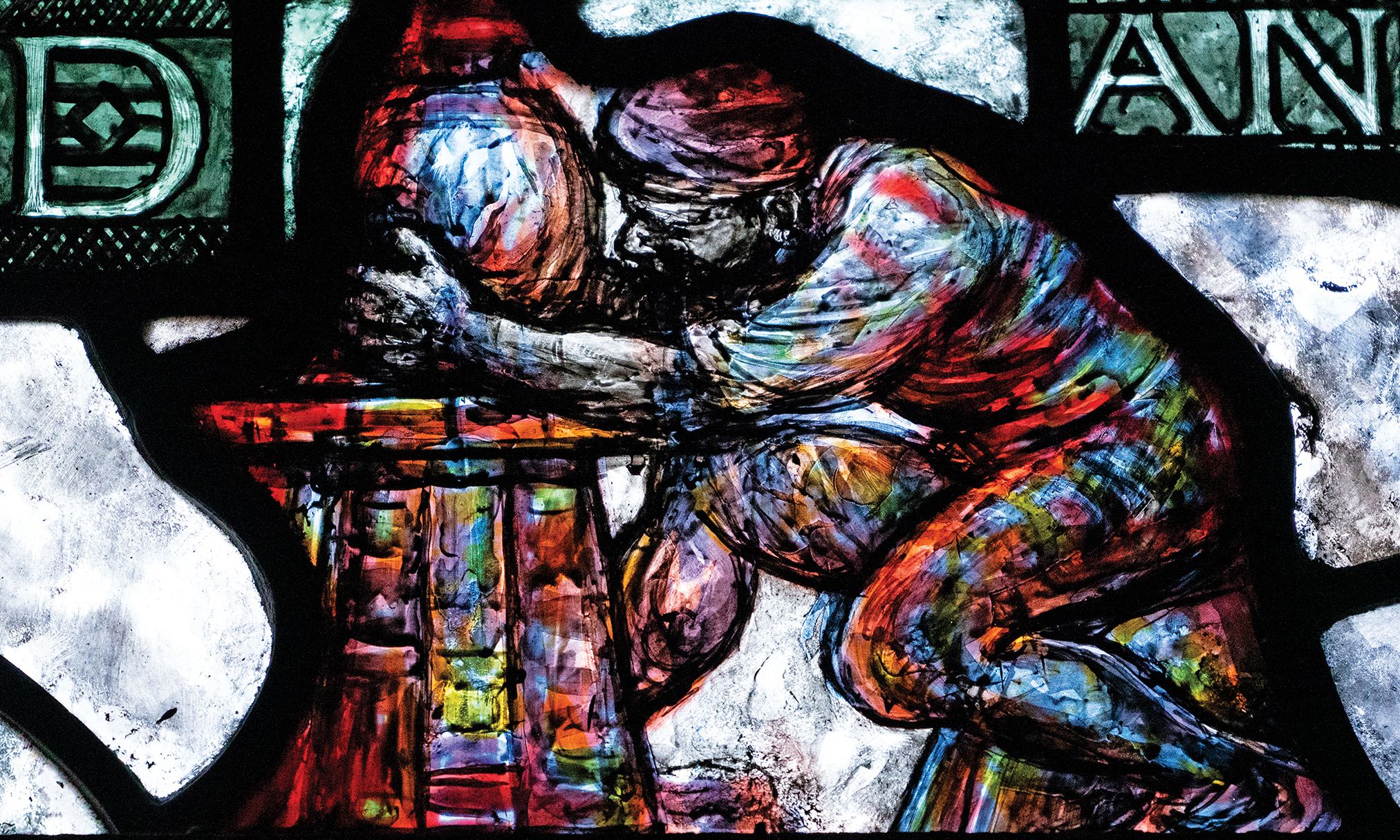Detail of The Potter (1923), at the Church of the Most Holy Rosary in Bridge a Crinn, County Louth, Ireland
Photo: Jozef Vrtiel
The saints and angels created in the early 20th century by the Irish stained-glass artist Michael Healy look down in a blaze of heavenly light from a jewelled world. The clergy and wealthy middle-class patrons who commissioned windows for churches across Ireland and England, even as far as New Zealand and Texas, could hardly have believed how different the artist’s own world was.
Healy was part of a new Irish school of stained glass, driven by the urge to supply Irish-designed and made windows for scores of Roman Catholic churches being built, extended or restored, often funded by a newly prosperous Catholic middle class, and strongly linked—as was the revival of interest in Irish art and language in general—to the nationalist movement.
Healy’s working life was radiant with colour, as he pushed ever further techniques of plating pieces of glass together to intensify hues, and acid etching to add sparkling light. The artist’s own life could hardly have been more grey and, as with his younger (and infinitely more famous) contemporary the stained-glass artist Harry Clarke, the materials he used may have contributed to his relatively early death in 1941 aged 68; David Caron suggests that Clarke’s own use of acid etching was influenced by Healy’s pioneering work in the technique.
Detail of the Angel Gabriel in The Annunciation (1937-38), at Blackrock College chapel, Blackrock, Dublin
Photo: Jozef Vrtiel
Healy’s glass working life was entirely at An Túr Gloine—”the glass tower”—studio, founded in 1903 by Sarah Purser, where she and most of his colleagues were middle class, often Anglo-Irish, including Evie Hone, the most famous of the studio artists. Purser commented, after almost 40 years: “I have worked for a long time with Mr Healy but I feel that I do not know him at all.” Very few did.
Caron’s inspired book, Michael Healy, 1873-1941, An Túr Gloine’s Stained Glass Pioneer, is more archaeology than conventional biography. There are only a handful of photographs, with Healy firmly in the background. He was never filmed or recorded. He left 13 letters in his room on his death, and apparently only four weeks of his daily journal survive. Caron also had just three essays by two Dublin art historians who knew him. Thomas MacGreevy, a future director of Dublin’s National Gallery, had visited Healy in the studio and chatted about shared interests in history, religion and nationalist politics, describing him as “the pioneer artist of the Irish stained glass movement”; and C. P. Curran, the critic and writer on architecture, wrote: “Healy’s life was almost that of a recluse, passed among a very limited and rarely extended circle of friends; he exhibited seldom, belonged to no academy, and dropped silently out of life.”
Healy was born in 1873 into a one-room apartment in a tenement house over a foundry, at a time when observers agreed that Dublin’s slums had the ignoble distinction of being the worst in Europe. His parents moved repeatedly into even worse and cheaper lodgings. One sister died at home, his father and one brother in a workhouse. His younger brother Matthew, possibly the person he was closest to, died destitute in his 30s having buried three of his children. Healy is said to have drawn on any available surface from childhood and was obviously highly intelligent. But school ended at 14 when he got a job as a sugar boiler in a confectionery factory, dangerous enough work.
Somehow, out of small wages and the money he gave his family, he managed to save enough for evening art classes at the Dublin Metropolitan School of Art and changed his life forever. After Healy’s first illustrations were accepted for a Catholic journal, a clerical patron completed the transformation by sending him to study for 18 months in Florence, his only time living abroad. None of this can explain how he became such a radiant genius in a wholly unfamiliar medium.
MacGreevy and Curran visited Healy’s home after his death, a lodging house a few minutes’ walk from the street where he was born. They must have known the great secret of his life, which would certainly have destroyed his career in the deeply conservative society of the day. Healy was not just the lodger but for 34 years the lover of Elizabeth Kelly, who had been married twice; even if blamelessly widowed, their marriage would have been seen as dubious. In a heartbreakingly discreet letter Kelly says she has lost “the best friend I have ever had in the world”, and how good he was to her three sons: one was Dermuid, Kelly’s never acknowledged son with Healy.
What Caron did have as evidence and material for his biography was the work, the windows—and they are glorious. I plan a little pilgrimage in penance for my ignorance of his existence, and I suspect many readers of this special book will do likewise.
• Michael Healy, 1873-1941, An Túr Gloine’s Stained Glass Pioneer, by David Caron. Four Courts Press, 448pp, colour illustrations, €55,00/£50 (hb), published 6 October

